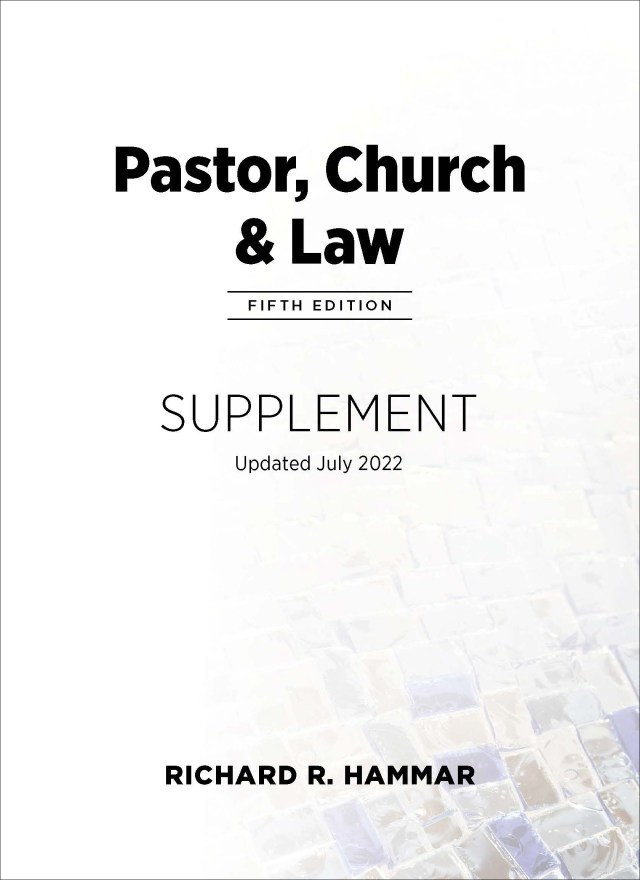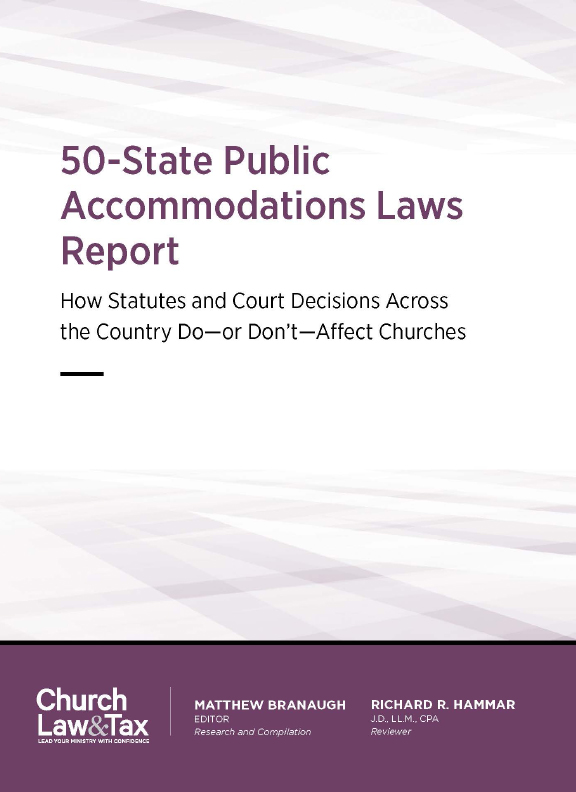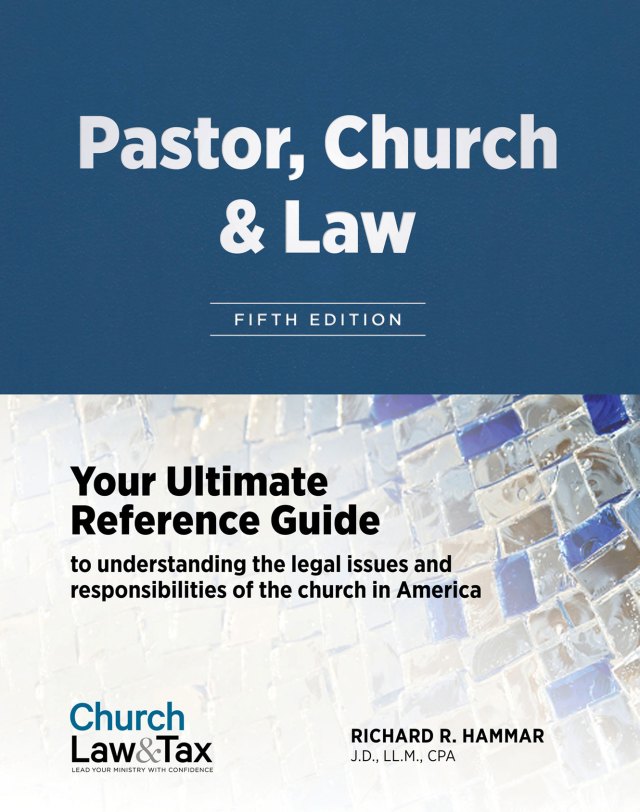Key point 8-24. A reference letter is a letter that evaluates the qualifications and suitability of a person for a particular position. Churches, like other employers, often use reference letters to screen new employees and volunteers. Churches often are asked to provide reference letters on current or former workers. The law generally provides employers with important protections when responding to a reference letter request. However, liability may still arise in some cases, such as if the employer acts with malice in drafting a reference letter.
Key point 10-16.5. The legal liability of churches and their officers, directors, and volunteers, is limited by state and federal “charitable immunity” laws.
An Ohio court ruled that a church was liable for a former pastor’s rape of a minor in another church since it had recommended him for a pastoral position despite knowledge of at least two incidents of child molestation. A 15-year-old girl (the “victim”) was raped by the senior pastor of her church (“Church A”) in the pastor’s office during a counseling session in 2008. The pastor (the “defendant”) pled guilty to two counts of sexual battery and was sentenced to two consecutive four-year prison terms.
The victim later learned that the defendant had previously worked in another church (“Church B”) as a youth pastor; that in the early 1990’s Church B learned that the defendant had engaged in sexually inappropriate sexual conduct with a minor female but took no action; that in 2001, Church B learned that the defendant had made inappropriate sexual comments to and inappropriately touched a female he was counseling but took no action; and, that in 2004, the defendant left his employment at Church B to become senior pastor of Church Awith the assistance, financial support, guidance, and supervision of Church B.
The victim sued Church B for negligent hiring, retention, or supervision, or negligent recommendation, promotion or support. During the trial, a young woman testified that in the early 1990’s, when she was between 13 and 16 years of age, her church went on a joint mission trip with Church B. The defendant was the youth pastor of Church B at the time. The woman testified that while at a concert during the mission trip, the defendant started rubbing her shoulders, moved his hand down her back between her shirt and the overalls she was wearing, and continued to move his hand down so his hand was on her skin on her lower back and the top area of her buttocks. The woman jerked forward and left the concert. She told her mother about the incident when she returned home. The mother informed the pastor of her church, and a meeting was convened with the mother and her daughter, the defendant, members of the church board, and representatives of Church B in attendance. During the meeting, the woman gave a full account of what happened to her, including that she felt scared and uncomfortable. The defendant apologized and said he was sorry if she felt uncomfortable. The woman testified that the representatives from Church B made light of this incident and acted as if she were making it up. The mother stated that, at the end of the meeting, one of the men from Church B said, “let’s just keep this quiet to protect our brother.” The mother was upset and felt the representatives from Church B were protecting the defendant. Neither the mother nor her daughter reported the incident to law enforcement and neither contacted Church B after the meeting to find out if it had taken any action with regard to the defendant.
The jury returned a verdict in favor of the victim in the amount of $1.5 million for past non-economic damages, $150,000 for future economic damages, and $2 million for future non-economic damages. The trial judge applied Ohio’s damages cap statute to reduce the award.
Another witness at the trial (“Amy”) testified that she attended Church B when the defendant was the youth pastor. In 2002, when she was eighteen (18) years old, she applied to go on a mission trip and had to meet with a pastor as part of the application process. When she met with the defendant, he did several things she felt were inappropriate, such as sharing the details of his sex life with his wife with her, touching her inappropriately, and telling her he could get away with having sex with her right there and then in his office, but his guilty conscience would stop him. Amy reported the incident to the pastor of Church B, who contacted the defendant for an explanation. The defendant claimed he did not remember saying or doing those things, but if he did, he was sorry.
The pastor of Church B testified that in 2002 he was the acting senior pastor at the church. He confirmed that though the defendant was leaving to be the senior pastor at Church A, he remained on the payroll of Church B until the end of 2005. Church B’s current pastor testified that the previous pastor did not inform him of the 2002 allegations by Amy; that the defendant’s behavior was inappropriate and should have been reported; and that if he had known of the 2002 incident he would not have recommended the defendant for the senior pastor position at Church A.
The defendant reported weekly to Church B’s elder board regarding his activities as senior pastor at Church A and, for a period of time, Church B’s pastor acted as his supervisor.
The jury found that Church B was liable for the victim’s injuries based on negligence since it was aware of the past behavior of the defendant and failed to do a proper investigation and documentation of the previous two incidents and, as a result, the defendant was empowered to a greater responsibility as senior pastor at Church A. The jury returned a verdict in favor of the victim in the amount of $1.5 million for past non-economic damages, $150,000 for future economic damages, and $2 million for future non-economic damages, for a total of $3.65 million.
The trial judge applied Ohio’s damages cap statute to reduce the award for the victim’s past and future non-economic damages to $350,000, and entered judgment for the victim in the amount of $500,000. The victim appealed.
The appeals court’s ruling
The appeals court began its opinion by noting that “the existence of an employer-employee relationship imposes a duty upon the employer to prevent foreseeable injury to others by exercising reasonable care to refrain from employing an incompetent employee. Injury is foreseeable if a defendant knew or should have known that his act was likely to result in harm to someone.” The foreseeability of a criminal act such as rape “depends upon the knowledge of the defendant, which must be determined by the totality of the circumstances.” The court concluded:
In this case, the two prior incidents which Church B became aware of both consisted of sexual misconduct and involved minor females being supervised or counseled by the defendant as a church employee either at the church or at a church camp. In light of this similar prior conduct, we find the totality of the circumstances indicates that a reasonable jury could have found that Church B should have reasonably foreseen the 2008 incident.
The court also refused to reverse the jury’s conclusion that Church B failed to take reasonable steps to protect the victim and whether the prior incidents should have influenced the church’s retention and promotion of the defendant to Church A.
Finally, the court rejected the victim’s argument that an Ohio statute that capped future noneconomic damages (i.e., pain and suffering) at $350,000 was unconstitutional.
What This Means For Churches:
This case illustrates the legal risk that is assumed by a church in not handling allegations of sexual misconduct properly, in not reporting child abuse to the civil authorities, and in affirmatively recommending perpetrators of child abuse for positions in other churches.
On the other hand, the court affirmed the constitutionality of a $350,000 cap on future, noneconomic damages in civil cases. Some states have enacted such laws, and they may protect a church from runaway verdicts. Simpkins v. Grace Church, 16 N.E.3d 687 (Ohio App. 2014).
* See also “Insurance,” Interstate Fire & Casualty Company v. Roman Catholic Church of Diocese, 761 F.3d 953 (9th Cir. 2014), in the Recent Developments section of this newsletter.




